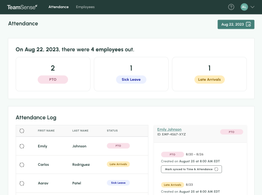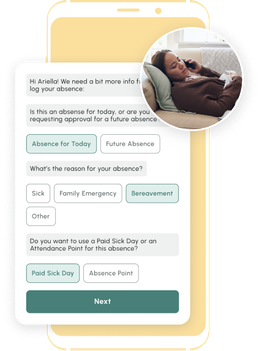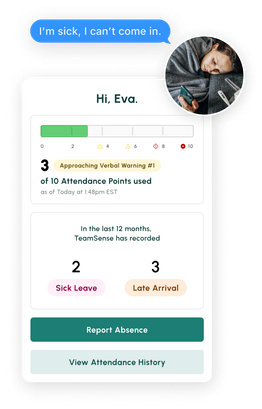Fix the root cause of No-Call No-Show with help from TeamSense
Thanks to The Great Resignation, we’ve heard plenty about employee turnover rates, retention, and the mass exodus of team members leaving their companies to take on new roles. At the same time, absenteeism is becoming an ongoing issue impacting every industry. Those two things might sound completely unrelated, but did you know absenteeism and employee turnover are linked? It's true—absenteeism is often an early warning sign of an employee about to exit.
Let’s uncover why employee turnover and absenteeism rates are increasing. Plus, actionable steps you can take to cut back on employee turnover and absenteeism at your company.
What is employee turnover?
Employee turnover refers to the number of employees who leave your organization (usually during a specific time). Since 2010, employee turnover has increased every year (with the only exception being 2020).1
Employee turnover happens and is a regular flow in a company—team members leave the area or move on to different career paths. Because of this, some turnover within a company is to be expected.
What is absenteeism?
Absenteeism happens when a team member makes a habit of being absent from work (usually without giving a reason or notice). Absenteeism costs can chip away at your company’s profits and productivity each year, with costs adding up to $3,600 per absent hourly employee per year.2
It's pretty easy to see that absenteeism is a big problem. Still, we're not talking about a team member taking PTO for a scheduled summer vacation or suddenly coming down with the flu and calling out sick. When we say "absenteeism," we mean when an employee has been absent from work a lot…and they probably don't give a reason for it either.
Planned absences include things like PTO vacation and even long leave requests. They are absences that are planned and approved ahead of time. Unplanned absences are the opposite and can include emergencies, illness, injury, or personal matters. An unexpected absence is just like it sounds—no one saw it coming.
Even though employee absences happen (and should be expected), there are still ways to learn how to reduce absences and lower the number of team members who are out.
What causes employee turnover and absenteeism?
A variety of factors can cause employee turnover and absenteeism—everything from personal reasons to workplace issues. Let's cover a few of these reasons employees call out of work.
Common reasons for employee turnover:
Health concerns
Found a job that paid more money
Moved to another city
Treated unfairly
Limited growth opportunities
Found a job closer to home
Burnout and stress
Little or no recognition of employees
Little or no feedback for employees
Overworked
Wanted a flexible schedule
Not on board with the company mission
Common reasons employees are absent from work:
Illness of employee or family member
Burnout and stress
Car or home emergency
Death of a family member
Stress
Burnout
Boredom
Low morale
Fatigue
Harassment
Workplace bullying
Disengagement
Health issues
Sickness
Injury
Job hunting
Family-related issues
Childcare and elder care
Lack of enjoyment in their job
Missing a sense of belonging
Not happy with their boss

Save Hundreds of Hours A Year With TeamSense
See how TeamSense saved HelloFresh 3-4 hours per day managing attendance through text. Read the case study and book your demo today!
5 Reasons Employee Turnover and Absenteeism Rates Are Increasing
Employee turnover and absenteeism rates are two of the most important HR metrics to keep tabs on. And seeing these two metrics go up can really make your HR team nervous. But before you know how to stop these metrics from continuing at your company, you have to understand why employee turnover and absenteeism rates are increasing. Here are five of the top reasons why.
1. Employee Burnout
Overworked employees are a negative trend that has continued since the pandemic. And the hourly and essential workforce has taken a big hit here.
These employees spent much of the pandemic working more hours than expected to make up for employees who were out sick or in quarantine. As time has gone on, the ongoing labor shortage has only made the issue worse—with more hourly employees taking on extra shifts to fill the gaps in scheduling when they are understaffed.
Employees who feel burnout in their current role are more likely to be absent and eventually leave your company. But the good news is that taking steps to prevent employee burnout doesn't take much effort. It can be as easy as just reassuring a team member that when they go home for the day, they need to “leave work at work” and not check email or prep for the next day’s shift after hours.
Notice someone on your team who hasn’t taken a break in a while? Give them a nudge to remember to take their PTO vacation. And when they're sick, set the precedent that they need to go home, take it easy, and rest instead of pushing through at work.
2. Employee Disengagement
Disengaged employees contribute largely to employee turnover and absenteeism rates increasing.
Making an effort to keep employees engaged will pay off big time for your company. A high level of employee engagement can reduce absenteeism by as much as 81%.3 And 71% of employees say they are more effective at their job when they feel heard.4 Engagement and pulse surveys are a great way to communicate with your team and get a feeling for their overall morale.
If you really want to get a better picture of how things are for your employees, there's no better way than talking with your team. Find out what you can do to create an environment where people don't want to always be absent.
Questions to ask your employees in engagement surveys:
Do you feel valued and supported as an employee?
Do you feel like your needs and career goals are being met?
Do you have a good relationship with your supervisor?
Do you have adequate advancement opportunities?
3. Toxic Company Culture
If your company culture has a reputation for being a hostile and toxic workplace, then expect your turnover and absenteeism rate to increase. People don't like working in an environment that constantly drains their attitude, morale, and mental health. In fact, one in five employees has left a job due to toxic workplace culture.5
A toxic company culture impacts your bottom line too. SHRM found that employee turnover due to culture may have cost companies as much as $223 billion over the last five years.6
That’s why it’s so essential to cultivate an employee-centric culture that is positive and builds connections between your team. Survey your employees and see how they view your culture currently, then see where you can take steps to improve.
4. Workplace Conflict
About 1 in 4 working Americans dread going to work, and workplace conflict could be a large part of that.7 If there are unresolved conflicts with co-workers, managers, or leadership, it can make for a pretty hostile environment. If the issues remain, it can easily lead to an employee being absent continuously. It may even lead to that employee exiting the company.
So what can you do about conflict in the workplace? Address issues as soon as they happen. If you notice a shouting match between two team members on the factory floor, put an end to it. You can allow time for them to cool off, but then be proactive and discuss the issue. It’s a good idea to speak with each employee individually to find out what happened and facilitate positive change.
Whatever you do, don’t let conflict go unresolved.
5. Employee Health Issues
One of the biggest reasons for absenteeism rates increasing is caused by employee health issues. From mild sicknesses like cold and flu bugs to more severe issues like chronic conditions and injuries, employees' health directly impacts their ability to come to work.
The best thing you can do to support your team is to offer competitive medical benefits so that your team can get the kind of help they need. And remember, it’s common for employees to miss a day of work now and again for sickness. Be sure that you provide enough sick leave throughout the year, so your team feels comfortable using it when they need to.

No one wants to talk to their boss or a 1-800 stranger to call off. Text changes everything - Reducing No Call No Shows.
How To Reduce Employee Absenteeism and Turnover in the Workplace
To reduce employee turnover and absenteeism, you need to have a better picture of what contributes to your organization's turnover and absenteeism problem.
Create and enforce an attendance policy.
In your employee handbook, you should specifically address attendance with an official attendance policy. For example, specify the general rules for attendance specific to your company, such as shift work or required weekly hours.
List approved absences and if any documentation is needed (such as a doctor's note for illnesses). Finally, highlight any methods or tools for tracking leave and absences and the consequences of not following these policies. Keep on top of the policies in place with reliable absence management software.
Embrace flexible schedules.
There’s no denying everyone’s plate is full with life responsibilities and family obligations these days. Given that, it might be time to think about what kind of flexibility you can offer at your company. Flexibility doesn’t just mean offering hybrid or work-from-home options. Flexibility for the hourly workforce can look like adding buffers to clock in time, shift schedules, locations, and making up time. If you want to reduce absenteeism rates, offering flexible ways to make up the lost time is key.
According to the Harvard Business Review, employees who don’t have flexibility at work are twice as likely to say they are dissatisfied at work, and half of employees said they would even leave their current company if they were offered a more flexible alternative with another company.8
So what does flexibility look like at your company? It could be something simple like a grace policy when it comes to clock-ins or letting employees stay longer to make up the time. Take a step back to reflect on what flexibility might mean to your employees and embrace a time off process that benefits both of you.
Enhance employee engagement and communication.
Having an open forum for your team to share their feedback is essential to the health and growth of a company. Gallup found that companies in the top quartile of employee engagement have reduced absenteeism by 81 percent.9 As if that wasn’t a stunning finding already, the study went on to show that there was 18 percent less turnover in high-turnover organizations and 43 percent less turnover in low-turnover organizations.10
That’s why employee engagement and pulse surveys should be a must at your company.
And when you get those engagement surveys back from your team, use those insights when you make decisions to propel the company forward. Some companies think they’re done once they send out the engagement surveys and get at least 3/4 participation. But getting that feedback does you no good if you don’t use it. Be sure you take a good, hard look at the data you receive and then use it to create a better employee experience for your team.
Offer training and career development opportunities.
Lack of career development and training opportunities has been listed as the number one reason employees leave a company—for the past ten years.11 Yikes. Long story short? If you don’t invest in your team’s career growth, they’ll go somewhere that will.
A career development plan for your team members is essential to reduce employee turnover and absenteeism. And the investment will definitely pay off in the end. Companies with robust training and career development platforms can reduce employee turnover by 30-50 percent.12
Cut Back on Absenteeism Using Attendance Management
Employee turnover is one of the most important HR metrics, and excessive absenteeism is a strong predictor of future employee turnover problems. If you want to make sure absenteeism doesn’t lead to employee turnover, you’ve got to get a handle on it.
An attendance management system will help you keep track of who's in and who's out for the day—plus, it will also show you how many absences certain employees have stacked up throughout the year. This way, you can step in to stop absenteeism before it increases employee turnover at your company. TeamSense's text-based attendance tool makes it easy to track absences without needing any clunky apps or complicated logins.

Is your call-in process terrible? Text reduces no-shows and absenteeism by up to 40%.
Don't believe us? Check out this case study to see how this 3PL benefited.
About the Author

Sheila Stafford, CEO of TeamSense & AI in HR Innovator
As CEO of TeamSense, Sheila Stafford is at the forefront of transforming HR for frontline teams through AI-driven solutions. With a commitment to enhancing employee relations and simplifying workforce management, Sheila leads TeamSense in pioneering advancements that empower both frontline employees and HR teams. Her visionary approach combines cutting-edge technology with a thoughtful focus on enhancing human connection; Sheila strategically implements AI where it adds the most value while recognizing the critical role of personal interaction and ensuring that human engagement remains central when it matters most. Under her leadership, TeamSense is redefining how companies support and engage their frontline teams for a more connected, efficient workplace.





